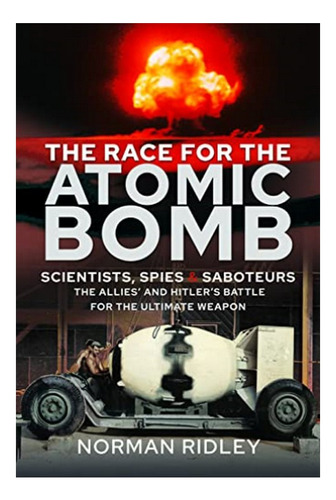The Race For The Atomic Bomb - Norman Ridley. Eb7
Pagá en cuotas
Llega gratis el sábado 13 de julio
Solo en CABA y zonas de GBA
Comprando dentro de las próximas 15 h 16 min
Retirá gratis entre el 15 y el 18/jul en correo y otros puntos
Ver en el mapaDisponible 45 días después de tu compra
MercadoLíder | +500 ventas
MercadoLíder Gold
+500
Ventas concretadas
Brinda buena atención
Despacha sus productos a tiempo



Descripción
Somos una librería que se dedica a traer libros importados, trabajamos con los principales proveedores internacionales y editoriales, siendo nuestros libros originales y asegurando la calidad del mismo.
Una vez realizada la compra el proveedor envía el libro a nuestro deposito para su despacho, una vez despachado se envían los datos para su seguimiento.
Brindamos garantía sobre nuestros libros y MercadoLibre asegura su dinero hasta que reciba el libro de conformidad.
EL COSTO DE ENVIO ES GRATIS. SE REALIZAN ENVIOS A TODO EL PAIS.
El plazo de entrega del libro hasta su puerta es de 29 días aproximadamente.
Contamos con gran catalogo de libros, si no lo tenemos publicado lo conseguimos.
Cualquier duda o consulta estamos a su disposición.
ESMERALDA BOOKS.
Descripción: Scientists, Spies and Saboteurs - The Allies' and Hitler's Battle for the Ultimate Weapon. The full story of the various warring nations' race to be the first to develop the atomic bomb. On 19 December 1938, Otto Hahn, working at the Kaiser Wilhelm Institute for Chemistry in Berlin, conducted an experiment the results of which baffled him. It took his migr collaborator Lise Meitner to explain that he had split an atom of uranium, which at the time seemed to defy all known laws of physics. When Neils Bohr took this news to the United States it became clear to scientists there that these results opened a completely new and, for some, horrifying possibility of energy production that could be used for both peaceful and military purposes.Scientists in Germany, France, Britain and the US began to delve deeper into the implications. But it was the British government that was the first to explicitly describe how the splitting of the atom might be utilised to create a practical weapon of fearsome power.France, by then, had been occupied by the Germans and most of their nuclear scientists had fled to Britain. For their part, the Germans, who for a time were at the very forefront of nuclear research, had weakened their own scientific ranks by hounding many of their best scientists who had fled persecution under the draconian Nazi racial laws. They still retained, however, possibly the ablest nuclear scientist of them all in Werner Heisenberg who set about developing his own programme for nuclear power.British scientists made extensive progress before realising that translating their laboratory results into the vast industrial enterprise required to build a bomb was way beyond the nation's stretched resources. The government agreed to hand over all the UK's research findings to America in return for a share of the spoils. The United States, for its part, was impressed with British results and invested enormous sums of money and resources into what became known as the Manhattan Project in a concerted effort to build a bomb before the end of the war.For much of the war the Soviets showed little enthusiasm for the sort of investment required to build their own bomb. However, with an eye to the future they established an extensive espionage network both in Britain and America.Following the German surrender there was still the problem of Japan, and the race continued to develop a working bomb to accelerate the end of the war, both to save Allied lives and to prevent Soviet expansion into northern China and the Japanese mainland. It was a race that the Unites States won. It was also a race that ushered in a new Cold War.
Preguntas y respuestas
¿Qué querés saber?
Preguntale al vendedor
Nadie hizo preguntas todavía. ¡Hacé la primera!
